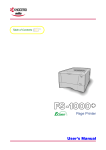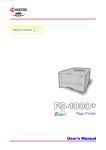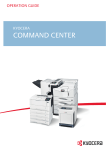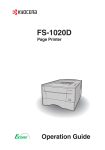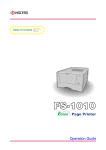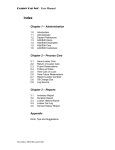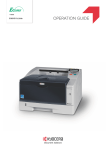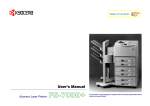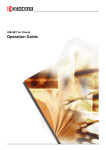Download KYOCERA Laserprinter FS-2000DN
Transcript
KM-NET for Clients Operation Guide Legal and General Information Notice Unauthorized reproduction of all or part of this guide is prohibited. The information in this guide is subject to change without notice. Kyocera Mita cannot be held liable for any problems arising from the use of this product, regardless of the information herein. Regarding Trademarks KYOCERA, KYOCERA MITA, ECOSYS and PRESCRIBE are registered trademarks of Kyocera Corporation. KPDL and KIR (Kyocera Image Refinement) are trademarks of Kyocera Corporation. Microsoft, Windows and Windows NT are registered trademarks of Microsoft Corporation. Apple, AppleTalk, Mac, Macintosh, Mac OS and TrueType are registered trademarks of Apple Computer, Inc. Adobe, Acrobat and Postscript are registered trademarks of Adobe Systems Incorporated. Novell and NetWare are registered trademarks of Novell, Inc. HP and PCL are registered trademarks of Hewlett-Packard Company. Intel, Pentium and Celeron are registered trademarks of Intel Corporation. Other brand and product names contained in this document are registered trademarks or trademarks of their respective companies. General Information When using this utility, the items that can be configured will differ depending on the model of your printing system or multifunctional printer (hereinafter referred to as "printing system"). Examples in this document are described in terms of the Internet Explorer 6.0 and Microsoft Windows XP operating system environment. Table of Contents 1. Features ................................................................................................................. 1 1.1. What is KM-NET for Clients? .......................................................................... 1 1.2. System Requirements..................................................................................... 1 1.3. Support Language .......................................................................................... 2 2. Installation and Startup ........................................................................................ 3 2.1. Installation....................................................................................................... 3 2.2. Startup ............................................................................................................ 3 3. Main Screen........................................................................................................... 4 3.1. Views and Buttons .......................................................................................... 4 3.2. Settings ........................................................................................................... 8 4. Add Printing System Wizard .............................................................................. 10 4.1. Adding the Printing Systems Using Standard Mode ..................................... 10 4.2. Adding the Printing Systems Using Advanced Mode.................................... 11 4.3. Adding the Printing Systems Using History Mode ........................................ 14 5. Properties ............................................................................................................ 15 5.1. Accessing the Properties Dialog Box............................................................ 15 5.2. Status Tab..................................................................................................... 16 5.3. Input Tab....................................................................................................... 17 5.4. Output Tab .................................................................................................... 17 5.5. Media Tab ..................................................................................................... 18 5.6. Printer Tab .................................................................................................... 19 5.7. Copy Tab ...................................................................................................... 20 5.8. Scan Tab....................................................................................................... 21 5.9. FAX Basic Tab .............................................................................................. 22 5.10. FAX Advanced Tab....................................................................................... 25 5.11. Resources Tab.............................................................................................. 27 5.12. Consumable Tab........................................................................................... 28 5.13. Counters Tab ................................................................................................ 28 5.14. Management Tab.......................................................................................... 29 5.15. Interface Tab................................................................................................. 31 6. Address Book...................................................................................................... 32 6.1. Address Book Window.................................................................................. 32 6.2. Search and Filtering Functions ..................................................................... 34 6.3. Edit Address Dialog Box ............................................................................... 35 6.4. Edit Group Dialog Box .................................................................................. 40 7. Job Manager ........................................................................................................ 41 8. Job Viewer ........................................................................................................... 42 8.1. What is Job Viewer? ..................................................................................... 42 8.2. Using the Job Viewer .................................................................................... 42 9. Broadcast ............................................................................................................ 45 9.1. Broadcast...................................................................................................... 45 9.2. FRPO Parameter Setting .............................................................................. 46 10. Document Box..................................................................................................... 47 11. Troubleshooting.................................................................................................. 50 Features 1. Features 1.1. What is KM-NET for Clients? KM-NET for Clients is a network utility intended for use to monitor and configure the printing systems and maintain e-MPS (enhanced-Multiple Printing System) jobs in storage devices. Monitoring the status of the printing system in real-time, confirming and modifying default settings and manipulating jobs stored temporarily or permanently can all be implemented between computers and printing systems. MFP KM-NET KM-NET Printer 1.2. System Requirements KM-NET for Clients operates in the following environment. Check the requirements before installation. Item Description OS Microsoft Windows 98 SE/Me Microsoft Windows 2000 Professional† Microsoft Windows XP Home Edition/Professional Edition† Web Browser Microsoft Internet Explorer 5.5 or later Hardware A processor equivalent to a Pentium 200 MHz or greater At least 32 MB of free memory At least 10 MB of free hard disk space SVGA (800 × 600, 256 color) or greater A sound card capable of playing WAV files (optional) Protocol TCP/IP IPX/SPX Interface Ethernet (10BASE-T/100BASE-TX) Parallel (IEEE1284) USB † Administrator rights are required for installation. Note When the printing system is used locally, conform that KX Driver has already been installed before using KM-NET for Clients. KM-NET for Clients 1 Features 1.3. Support Language KM-NET for Clients supports the following languages: Arabic, Brazilian Portuguese, Czech, Danish, Dutch, English, Farsi, Finish, French, German, Hebrew, Hungarian, Italian, Lithuanian, Japanese, Korean, Norwegian, Polish, Russian, Simplified Chinese, Spanish, Swedish, Traditional Chinese and Turkish. 2 KM-NET for Clients Installation and Startup 2. Installation and Startup 2.1. Installation Install KM-NET for Clients on your computer. Note Before installing this application, check that the KX driver is installed on the computer. KX Driver is on the CD-ROM supplied with the printing system. Insert the CD-ROM that came with the printing system into the optical drive of the computer. The installation program starts up automatically. Follow the installation instructions. 2.2. Startup When the installation is completed, start the KM-NET for Clients by proceeding from the start menu > All Programs > Kyocera > KM-NET for Clients. KM-NET for Clients 3 Main Screen 3. Main Screen 3.1. Views and Buttons The main screen is explained below. 10 1 2 3 4 5 6 7 8 9 The following table explains the views and buttons on the main screen of KM-NET for Clients. The numbers appearing in the figure above are referred to in the Reference Number column on the following pages. Note The explanations of messages appearing in this manual are based on the premise that the printing system is used over a network. Accordingly, the explanations include some messages that do not appear when the printing system is used locally. 4 KM-NET for Clients Main Screen Ref. Name and Icon No. Description 1 The Connection View displays connected printing system icons for that have been discovered through the printer discovery process. Connection View A maximum of five printing system icons can be displayed in this view. Each icon describes the status of the printing system. Ready Not connected Error Warning Sleep Add button Click this button to start the wizard. Follow instructions to add the printing system. Remove button Select the icon for the desired printing system within the Connection view, and click this button to remove the printing system. KM-NET for Clients 5 Main Screen Ref. Name and Icon No. Description 2 The Information View is located below the Connection View and describes the status of the printing system in greater detail. Information View Depending on the printing system, the status icons shown in the information view is different. Status Icon Pattern 1 The printing system is ready to print. The paper runs out or the cassette is not installed properly. A paper jam has occurred. Toner is low or runs out. When the toner becomes low, the icon blinks. When the loner runs out, the icon lights up. An error has occurred. Status Icon Pattern 2 The printing system is ready to print. An error occurs for printing. The printing system is ready to scan. An error occurs for scanning. The printing system is ready to fax. An error occurs for fax. Switch status information by clicking the icons circled by red in the left images. The various type of icons are displayed on Information View according to options attached to printing system and specific features. For details, refer to online help. 6 KM-NET for Clients Main Screen Ref. Name and Icon No. Description 3 3D View can be set up to display a 3D rendering of the selected printing system. It displays the status of the printing system in real-time. 3D View For example, if the top cover of the printing system is opened, the top cover of the 3D image also opens. 4 Properties Button Click this button to open the properties dialog box. The dialog box displays detailed information about the printing system. For details, refer to the section Properties. 5 Job Manager Button Job Viewer Button Click the Job Manager button to open the Job Manager window and click the Job Viewer button to open the Job Viewer window. These windows enable the user to obtain job information and administer jobs stored in the storage devices in the printing system. These buttons are available only when a hard disk is installed. The button to be displayed will differ depending on the model. For details, refer to Job Manager on page 41 or Job Viewer on page 42. 6 Broadcast Button Click this button to open the Broadcast dialog box. For details, refer to Broadcast. 7 Document Box Button Click this button to open the Document Box window. For details, refer to Document Box on page 47. 8 Setup Button The Setup button has 2 tabs. For details, refer to Settings. Status Polling Tab Set up a polling interval and audible notification for device error conditions here. Appearance Tab Set up a 3D image view and the appearance of this utility here. 9 KM-NET for Clients Help Button The Help button displays the help window.display 7 Main Screen Ref. Name and Icon No. Description 10 Click Title Bar in the title bar to display the menu. About KM-NET for Clients Displays the version information on KM-NET for Clients. 3.2. Settings When operating KM-NET for Clients, you can change settings for polling interval, audible (error) notification, whether you want to use the 3D virtual printing system to monitor the printing system status, etc. 1 2 Click SETUP on the main screen. The KM-NET for Clients dialog box appears. Configure the settings for status polling and appearance. Status Polling Tab Polling When Polling is activated (check box checked), KM-NET for Clients logs itself onto the printing system and automatically recognizes printing system changes at predetermined intervals. The interval can be configured by moving the slider with the mouse. The default setting is 5 seconds. Polling should normally be left activated (check box checked). Audible Notification When Audible notification is activated (check box checked), a sound is played when an error occurs. Specify the WAVE file (.wav file extension) by clicking Browse and browsing for the folder that contains it. 8 KM-NET for Clients Main Screen Appearance Tab Show 3D image This displays the 3D virtual printing system for monitoring the status of the printing system. 3D accelerator Select the method which the PC renders the 3D image. The default is Software rendering. Selecting Hardware rendering may improve the performance of rendering the 3D image depending on the hardware requirement. Show on Taskbar When minimizing the main screen, the taskbar button will disappear from the task tray, and an application icon will be displayed in the task tray. When clicking the icon, the main screen resizes. When an error occurs, the main screen with the type of error notification will be displayed. If the box is unchecked, then a minimized button will be displayed on the task bar. Always on top Error notification is given by a message that is displayed on top of all other windows that may be currently open on the desktop. KM-NET for Clients 9 Add Printing System Wizard 4. Add Printing System Wizard To search for printing systems to be registered, click Add System Wizard starts. . The Add Printing 4.1. Adding the Printing Systems Using Standard Mode To add the printing systems using standard mode, perform the following procedure. 1 2 3 4 10 Select Standard. Select the check box for Network or Local connection according to the desired printing system. Click Next. Perform the instructions displayed by the wizard. The instructions are different depending on the connection type selected above. KM-NET for Clients Add Printing System Wizard 5 6 After searching completes, the searched printing systems are displayed. Up to five desired printing systems can be selected. To select multiple printing systems, press and hold Ctrl key and click on the desired printing system name. Click Finish to return the main screen. The Connection View displays the icon for the selected printing system. 4.2. Adding the Printing Systems Using Advanced Mode Advanced mode has the following three options below to find the printing systems. Option Description Local printer Finds the printing system by selecting the local printer name installed on PC. Network address Finds the printing system by entering the network address. Import printing systems Imports printing systems from the selected file. Local Printer To add printing system using local printer option, perform the following procedure. 1 2 KM-NET for Clients Select Advanced. Click Next. 11 Add Printing System Wizard 3 4 5 Select Local printer. Click Next. Perform the instructions displayed by the wizard. Network Address To add printing system using network address option, perform the following procedure. 1 2 3 4 12 Select Advanced. Click Next. Select Network address. Click Next. KM-NET for Clients Add Printing System Wizard 5 6 Select the protocol for printing system discovery. Perform the instructions displayed by the wizard. The instructions are different depending on the protocol selected above. Import Printing Systems To add printing system using import printing systems option, perform the following procedure. 1 2 3 4 5 6 KM-NET for Clients Select Advanced. Click Next. Select Import printing systems. Click Next. Select one data file to import network address. The data file that can be imported is the CSV file exported by Network Print Monitor. Click Next. 13 Add Printing System Wizard 7 Perform the instructions displayed by the wizard. 4.3. Adding the Printing Systems Using History Mode History mode displays the printing systems that were previously searched using standard mode or IP range discover in advanced mode. To add the printing system using history mode, perform the following procedure. 1 2 3 4 14 Select History. Click Next. The printing systems that were previously searched are displayed. Select the desired printing system up to five. To select multiple printing systems, press and hold Ctrl key and click on the desired printing system name. Click Finish. KM-NET for Clients Properties 5. Properties 5.1. Accessing the Properties Dialog Box When you click the Properties button on the main screen, the printing system properties dialog box as shown below appears. For details of the property items, refer to Help. Notes • The contents of the printing system property will be different depending on the printing system model, the installed optional devices, and whether the printing system is connected via network interface or local interface. Also, if the printing system does not support color printing, only the level of remaining black toner will be displayed. • The default settings and the range of possible values in this utility may be different depending on the printing system model. For details, refer to the Operation Guide of the each printing system. • If you have set a password for the printing system, a password prompt will appear. Enter your password and click OK. The properties dialog box appears. • If you have set the user login function for the printing system, a login prompt will appear. Enter login user name and login password and click OK. The properties dialog box appears. • If you are instructed during configuration, turn the printing system off and on. KM-NET for Clients 15 Properties 5.2. Status Tab Displays the current condition of the printing system. If an error occurs, Trouble tips appears instead of General information like below. 16 KM-NET for Clients Properties 5.3. Input Tab Displays information about the paper feeder attached with a printing system, such as the media size, the paper capacity and the maximum paper capacity. Depending on the printing system, the detailed setting of each media type can be configured in this tab. 5.4. Output Tab Specifies the destination which the print job is output to and configures the detailed settings of each output device. KM-NET for Clients 17 Properties 5.5. Media Tab Displays the settings for media. Main Item Sub Item Description Media type Weight Media weight can be set for the customized paper. Temperature The heat of fusing can be set for the customized paper. Density Print density can be set for the customized paper. Duplex Duplex printing can be set for the customized paper. Custom paper size Sets the custom size for the paper. Custom original size Sets the custom size for the original document. Offset Establishes the vertical and horizontal offsets of the print area for each feeder and the scan area for either the platen or the document processor. Paper size Offset 18 KM-NET for Clients Properties 5.6. Printer Tab Allows you to configure the settings for the printing function. Main Item Sub Item Description Print quality EcoPrint Enables the printing system to reduce the amount of toner consumption to save printing costs. Resolution Selects the resolution for printing. Tone Selects the way the printing system handles a pixel for representing the color and halftoning for each pixel. Gloss mode The gloss mode, when set to High, increases the effect of glossiness in printing. However, the printing speed slows down. KIR A smoothing function makes resolution higher and realizes a high quality print result. Color mode Selects the default color mode. Duplex mode Duplex printing is the mode of printing on both sides of paper. Copies Enables setting for the default number of copies. Page orientation Enables settings for Portrait or Landscape printing. Default emulation Allows you to change the emulation mode. Page control Emulation KM-NET for Clients 19 Properties 5.7. Copy Tab Allows you to check and configure the settings for the copy function. 20 Main Item Sub Item Description Feed APS media type When the Enable check box is selected, APS media type is activated. Alternatively, a Media type can be selected. KM-NET for Clients Properties 5.8. Scan Tab Allows you to check and configure the settings for the scanning function. Main Item Sub Item Description Basic Original size Displays the size of the original document. Zoom Select the zoom mode. Exposure Select the exposure mode for scanning. Scan color Select the color mode for scanning. Original quality Select the quality of the original document. Scan resolution Select the resolution for scanning. File format Select the file format. Copy exposure Adjust the exposure for copying. Use the slide bar to adjust the exposure of both Auto and Manual modes. Original orientation Select the orientation of the original document. Advanced KM-NET for Clients 21 Properties 5.9. FAX Basic Tab Allows you to configure the basic settings for the FAX function such as transmission, reception and encryption key settings. Main Item Sub Item Description Default FAX firmware Displays the FAX firmware version for each port. FAX line Select the FAX line type for each port. Pulse (10pps) Pulse (20pps) Tone (DTMF) Local FAX ID Specify the local FAX ID. The ID must be a 4-digit number between 0000 and 9999. Local FAX number Specify the local FAX number for each port. The FAX number must be 20 digits or less and can include numerical characters, "+," and spaces. Local FAX name Specify the local FAX name. Name Specify the local FAX name. The maximum length of the FAX name is 32 characters. Transmit settings TTI 22 Select whether the TTI will be sent as well. TTI position Select the position where the TTI will be printed. Retry times Specify the number of redials for FAX transmission from 0 to 14. KM-NET for Clients Properties Main Item Sub Item Description Reception settings 1 FAX receive Select the FAX reception mode. Auto (FAX/TEL) Auto (Normal) Auto (TAD) Auto (DRD) * Manual * This is not displayed on European models. DRD pattern Select a ringing pattern when Auto (DRD) is selected in the FAX reception. This is not displayed on European models. Receive date/time Select whether the reception date and time is printed out on the received documents or not. 2 in 1 Select whether 2 pages of the received documents are printed on a single sheet. Remote switching dial number Change the dial number used in the remote switching function. Number of rings Set the number of rings until it switches to fax reception per FAX reception mode. AUTO: 1 - 15 TAD: 1 - 15 FAX/TEL: 0 - 15 Encryption reception Select whether the encryption is enabled or not. When enabled, specify the encryption key as well. Paper source settings Specify the paper feed setting in the FAX reception mode. Media type Select the type of paper to be used for printing. Use MP tray The MP tray will be the paper source when this is selected. Paper output settings Specify the output tray in the FAX reception mode. Output stack Select the tray printed papers will be delivered to. Reception settings 2 KM-NET for Clients 23 Properties Main Item Sub Item Description Reception settings 3 Duplex printing Select whether or not to allow duplex printing in the reception. Reduced reception size Select whether the received FAX will be printed primarily at the same magnification or at a reduced size. Encryption key 24 Reception port Specify the reception only port. OFF Port 1 Port 2 (If the optional device is attached) Encryption key settings Displays the list of encryption keys currently registered. Add button Adds a new encryption key. Delete button Deletes the encryption key selected in the list. Properties button Displays the details of the encryption key selected in the list. It is possible to edit the property. KM-NET for Clients Properties 5.10. FAX Advanced Tab Allows you to configure the advanced settings for FAX function such as transmit/receive restrictions, or report print out settings. KM-NET for Clients Main Item Sub Item Description Restriction Transmit restriction Select the list used for transmit restriction. OFF Permit list + Address Book When "Permit list + Address Book" is selected, transmission to the addresses in the Address Book and the FAX numbers and IDs in the permit list becomes possible. Receive restriction Select the list used for receive restriction. OFF Permit list + Address Book Reject list When "Permit list + Address Book" is selected, reception from the addresses in the Address Book and the FAX numbers and IDs in the permit list becomes possible. When "Reject list" is selected, transmission from the FAX numbers in the Reject list will be denied. 25 Properties Main Item Sub Item Description Permit List Permit number list Displays the list of FAX numbers currently registered. Add button Adds a new FAX number. Delete button Deletes the FAX number selected in the list. Properties button Allows the user to edit the FAX number selected in the list. Permit ID list Displays the list of FAX IDs currently registered. Add button Adds a new FAX ID. Delete button Deletes the FAX ID selected in the list. Properties button Enables the user to edit the FAX ID selected in the list. Reject number list Displays the list of FAX numbers currently registered. Add button Adds a new FAX number. Delete button Deletes the FAX number selected in the list. Properties button Allows the user to edit the FAX number selected in the list. Outgoing FAX report Select whether to record the FAX transmission in a report. Incoming FAX report Select whether to record the FAX reception in a report. Send result report Sends a result of the FAX transmission to a specified destination. OFF ON Error and forward only FAX reception result report Sends a result of the FAX reception to a specified destination. OFF ON Error and forward only FAX reception result report type Select whether to print out the FAX reception result or send it by E-mail. Destination Enter the E-mail address to where the FAX reception result will be sent. Reject list Report 26 KM-NET for Clients Properties 5.11. Resources Tab Displays information about all memory sources and data such as Font, Macro, Program and Host information. Main Item Sub Item Description Memory Memory information Displays the amount of free and total RAM and the available memory slots. Host buffer Displays and changes the host buffer mode and the host buffer size. Raster memory Displays and changes the setting of the raster memory size mode. When this setting is Auto, the memory capacity used for raster memory varies according to the condition. When this setting is On, the maximum size of the available memory is secured for it. Static storage Displays the memory capacity of the hard disk drive, memory cards and an option ROM. RAM disk Displays and changes the RAM disk size. Font Displays the fonts in the printing system. Macro Displays the macros in the printing system. Program Displays the program in the printing system. Host data Displays the host data in the printing system. Storage Data KM-NET for Clients 27 Properties 5.12. Consumable Tab Displays the remaining level of toner amount and each consumable unit life. 5.13. Counters Tab Displays the count information of the printing system. 28 Main Item Sub Item Description Printed pages - Displays the total number of printed pages. Scanned pages - Displays the total number of scanned pages by Function - Displays the page counter per function. KM-NET for Clients Properties Main Item Sub Item Description by Paper size - Displays the page per paper size. by Color mode - Displays the page counter per color. 5.14. Management Tab Allows you to configure the management settings of the printing system. Main Item Sub Item Description System Language Selects the language displayed on the message display. Buzzer A Buzzer can be set to sound when an error condition occurs on a printing system. The buzzer must be activated within the application. It is available only for those printing systems equipped with this function. Form feed timeout Adjusts the form feed timeout time. If the printer receives no data for a certain period, it will time out and release the current interface. It prints whatever data it has in its buffer and feeds out the page. Auto sleep Specifies sleep timer setting value. If the printing system has not been used for a specified time, it will enter sleep mode. Operation panel language Selects the language displayed on the message display. Default operation Selects the default operation at the initial state. Common KM-NET for Clients 29 Properties 30 Main Item Sub Item Description Timer Auto panel reset Specifies the time for auto panel reset. When this function is enabled, if no operation has been performed on the operator panel during a specified time, the display automatically returns to the default. Form feed timeout Adjusts the form feed timeout time. If the printer receives no data for a certain period, it will time out and release the current interface. It prints whatever data it has in its buffer and feeds out the page. Auto sleep Specifies sleep timer setting value. If the printing system has not been used for a specified time, it will enter sleep mode. Click Advanced to enable or disable the Auto Sleep. Security Panel lock Displays the setting of panel lock. Identification Asset number Specifies the Asset number for the printing system. The maximum length of asset number is 15 characters. The User defined settings Specifies the Nickname and Description for the printing system. The maximum length of nickname and description is 64 characters. Address Book Edit Click this button to open the Edit dialog box of the Address Book. For details, refer to Address Book on page 32. User login User list Confirms the users registered in the printing system. KM-NET for Clients Properties 5.15. Interface Tab Displays the general information for the network interface. KM-NET for Clients Main Item Sub Item Description General Network interface Displays the information of the network interface such as model name, firmware version, MAC address and serial number. Novell Novell configuration Configures the settings of Novell NetWare. TCP/IP TCP/IP configuration Displays the information of the TCP/IP configuration such as IP address, subnet mask, default gateway and TCP/ IP port. Serial Serial Configures the settings of the printing system's serial port. Protocol Protocol settings Enables or disables the protocol of the network interface such as FTP, AppleTalk, SMB, SMTP, NetWare, NetBEUI and IPP. 31 Address Book 6. Address Book In this section, we are viewing and editing the Address Book in the printing system. Addresses in the Address Book can be specified for transmission or restriction of transmission/reception. You can also group individual addresses for batch transmission. Note The Address Book is available only in a printing system with hard disk. 6.1. Address Book Window You can display the Edit dialog box of Address Book window by clicking Address Book in the main menu of the Management Tab, and then clicking Edit. The Address Book window displays the list of registered addresses. 32 KM-NET for Clients Address Book The search and filtering functions are available to help the user to quickly find the necessary address. Main Item Sub Item Description File Add Contact Registers a new address. Up to 2000 addresses can be registered. Add Group Registers a new group. Up to 500 groups can be registered. Import Imports addresses from a file. Export Exports the Address Book to a file. Close Exits the Address Book window. Edit Allows the user to edit the address or group selected in the address list. Copy Copies the address or group selected in the address list. Paste Pastes the copied data to the address list. Delete Deletes the address or group selected in the address list. Edit KM-NET for Clients 33 Address Book Main Item Sub Item Description View Column Allows the user to configure the columns displayed in the Address Book window. Help Help Displays the help window for the Address Book window. Address List Displays the list of registered addresses. 6.2. Search and Filtering Functions Helps the user to quickly find the address he/she wants. 34 Function Description Search box Enter a string in the search box (caseinsensitive). The entered string will be searched against the address data in the name column. If the string matches the leading part of an address, the address will be displayed in selected state. Filtering by Transmission Type When a filtering criterion is selected, address data that matches the criteria will be displayed in the address list. The item that has been checked in View menu > column will be displayed and become available to be selected. None Clears the filtering by transmission type. E-mail Displays address data that includes email addresses. FTP Displays address data that contains FTP addresses. SMB Displays address data that contains SMB addresses. FAX Displays address data that includes FAX numbers. Filtering by Address Type When a filtering criteria is selected, address data that matches the criteria will be displayed in the address list. None Clears the filtering by address type. Contacts Displays contact address data. Groups Displays group address data. KM-NET for Clients Address Book 6.3. Edit Address Dialog Box In the Edit Address dialog box, you can configure or edit addresses in detail. Name Tab KM-NET for Clients Item Description Name Enter the name. The maximum length of the Name is 32 characters. Address The address is displayed in the following format. E-Mail E-mail: E-mail Address FTP FTP: Path(Host Name) SMB SMB: Path(Host Name) FAX FAX: FAX number 35 Address Book Cover page Tab 36 Item Description Recipient Enter the name of the recipient. The maximum length of the destination name is 32 characters. Company Enter the name of the company. The maximum length of the company name is 32 characters. Department Enter the name of the department. The maximum length of the department name is 32 characters. KM-NET for Clients Address Book E-Mail Tab Item Description E-Mail Address Enter the e-mail address. The maximum length of the e-mail address is 126 characters. FTP Tab KM-NET for Clients Item Description Host Name Enter the host name of the FTP server. Specify the port number different from the default (21) using the format of Host Name: Port Number. The maximum length of the host name is 62 characters. Path Enter the path. The maximum length of the path is 126 characters. 37 Address Book Item Description Login user name Enter the login user name. The maximum length of the login user name is 62 characters. Login password Enter the login password. The maximum length of the login password is 62 characters. SMB Tab 38 Item Description Host Name Enter the host name. Specify the port number different from the default (139) using the format of Host Name: Port Number. The maximum length of the host name is 62 characters. Path Enter the path. The maximum length of the path is 126 characters. Browse button Click the browse button to open the Choose Folder dialog box. Login user name Enter the login user name. The maximum length of the login user name is 62 characters. Login password Enter the login password. The maximum length of the login password is 62 characters. KM-NET for Clients Address Book FAX Tab KM-NET for Clients Item Description FAX No. Enter the FAX number. The maximum length of the destination name is 32 characters. TX Start Speed Select the transmission speed from "33600bps," "14400bps" and "9600bps." ECM Select ON or OFF for ECM. Sub Address Enter the subaddress. The maximum length of the subaddress is 20 characters. Password Enter the password. Encryption Key No. Select "None" or "1 - 20" for the encryption code. Encryption box Select ON or OFF for the encrypted document box. Encryption box No. Enter the encrypted document box ID from 0000 to 9999. 39 Address Book 6.4. Edit Group Dialog Box In the Edit Group dialog box, you can create a group, or add or delete a member. The maximum number of members that can be registered in a group is: 40 • E-mail address: 100 • FTP and SMB (in total): 10 • FAX: 500 Item Description Group Name Enter the name of the group. The maximum length of the group name is 32 characters. Member List Displays the list of members registered for the group. Add Member button Click this button to open the group member detail dialog box. Delete button Deletes the member selected in the member list. OK button Saves the changes and closes the edit group dialog box. Cancel button Closes the edit group dialog box without saving the changes. KM-NET for Clients Job Manager 7. Job Manager The printing job can be stored in the storage devices of the printing system. This job is administered, reprinted and deleted using Job Manager function. Turning the printing system power off will not delete stored jobs. Note Job Manager can only be used in the printing system which installed storages devices. The Job Viewer may be displayed instead for particular printing systems. For details about Job Viewer, refer to Job Viewer on page 42. Job Manager Window Enables to print or delete jobs stored in printing systems’ storage devices using job manager. Also enables to print a job list. Perform the following procedure to operate the job(s) stored in the storage device. 1 2 3 KM-NET for Clients Select the job(s) to operate. Select the desired operation from the Operation menu. When you select Print operation, The print job wizard starts. Follow the instructions displayed by the wizard. 41 Job Viewer 8. Job Viewer 8.1. What is Job Viewer? Printing jobs can be stored on the hard disk drive (HDD) in the printing system. The job log can be downloaded or deleted using the Job Viewer. Stored jobs will not be deleted even if the printing system is turned off. Note Job Viewer can only be used in the printing system where a hard disk drive is installed. The Job Manager may be displayed instead for particular printing systems. For details about Job Manager, refer to Job Manager on page 41. 8.2. Using the Job Viewer The following procedure describes how to use the Job Viewer. 1 42 When you click the Job Viewer on the main screen, the Job Viewer screen appears. Pressing F7 on the keyboard also displays the Job Viewer screen. KM-NET for Clients Job Viewer 2 In this screen, you can view job information and administer jobs by selecting a job and selecting an action you want to apply from a menu or with an icon. Menu Cancel icon Update icon Details icon Status tab Schedule tab Log tab Main Item Sub Item Description File Save history Downloads the log into the computer. Clear Log Deletes all logs from the printing system. Close Exits Job Viewer. Detail Displays details of the selected job. Cancel Cancels a job that is being processed, waiting or pausing. Refresh Updates the job list to the latest state. Tool bar Displays/Hides the toolbar. Status bar Displays/Hides the status bar. Job View Help KM-NET for Clients Displays the Help window. Item Description Status tab Displays the current status of the printing system. Schedule tab Displays the schedule of jobs the printing system will process. 43 Job Viewer 44 Item Description Log tab Displays the log of printing activities made by the printing system. KM-NET for Clients Broadcast 9. Broadcast Allows you to send PRESCRIBE commands to the printing system (Broadcast). Also allows you to use this menu to confirm and change the internal settings of the printing system when using either a local or network connection (FRPO). For details on PRESCRIBE commands, refer to the PRESCRIBE Command Reference manual. For details on FRPO, refer to the Operation Guide of the printing system. Notes • Broadcast does not work with printing systems on an IPX network. • The FRPO parameter menu is not available depending on the printing system. 9.1. Broadcast Perform the following procedure to use the broadcast function. 1 KM-NET for Clients Click Broadcast to open the broadcast dialog box. 45 Broadcast The Broadcast dialog box appears. 2 3 Browse the command file or enter the command in the Broadcast text box. The maximum length of command is 256 characters. Click Send to send the command to the printing system. 9.2. FRPO Parameter Setting Perform the following procedure to change the FRPO parameter. 1 2 3 4 5 46 Click Broadcast to open the broadcast dialog box. The Broadcast dialog box appears. Enter the parameter (for example R4) in FRPO. Click Get. The current value is shown in Value. Erase the current value and enter the new value. For example, to change the default paper source to the MP Tray in the above example, enter 0 instead of 1 in Value. Click Set. The value is changed. KM-NET for Clients Document Box 10.Document Box Clicking the Document Box window. on the main screen displays the Document Box In the Document Box window, the user can preview documents in the printing system's hard disk drive and download them to a computer. KM-NET for Clients 47 Document Box Main Item Sub Item Description File Add Displays a dialog box where the user can create a new document box. Detail Displays the property of the selected document box. Close Closes the Document Box window. Move Displays a dialog box where the user can move the selected document to another document box. Delete Deletes the selected document box or document. Download Downloads the selected document to a computer. Edit 48 KM-NET for Clients Document Box Main Item Sub Item Description View Tool bar Displays or hides the tool bar. Status bar Displays or hides the status bar. Details Displays the documents in the list in report form. Thumbnail Displays the documents in the list in thumbnail form. Refresh Updates the data in the document box. Preview pane Displays the preview pane. Preview Previous page Displays the preview of the previous page. Next page Displays the preview of the next page. Zoom In Enlarges the preview image in steps. Zoom Out Reduces the preview image in steps. Rotate 90 CW Rotates the preview image 90 degrees clockwise. Rotate 90 CCW Rotates the preview image 90 degrees counterclockwise. Help KM-NET for Clients Help Displays the help window. 49 Troubleshooting 11.Troubleshooting If trouble occurs with using KM-NET for Clients, carry out the applicable remedy indicated below. If the trouble persists, contact your service representative or authorized service center. Symptom Cause Remedy The utility does not start. Your computer does not meet the system requirements. Upgrade or change your computer to meet the system requirements. For details, refer to System Requirements. A version of Microsoft Internet Explorer 5.1 or earlier is being used. Use Microsoft Internet Explorer 5.5 or later. Out of memory. Close all unnecessary applications. The utility is already running. It cannot be run twice. A maximum of five printing systems have been added. Reduce the number of connected printing systems to add a new printing system. The printing system has been turned off. Start searching after the printing system has been turned on. The printing system has been removed from the network. Start searching after the printing system has been connected to the network. The printing system is printing or processing data. Try to search for the printing system again after processing and printing are complete. The KX Driver is not installed in your computer. When the printing system is connected via local interface, the KX Driver must be installed in your computer. Add is grayed out. No printing system is discovered. TCP/IP or IPX/SPX protocol is When the printing system is not installed in your computer. connected via network interface, TCP/IP or IPX/SPX protocol must be installed in your computer. The TCP/IP or IPX/SPX settings on your computer is not configured properly. Contact your network administrator. Depending on the network router configuration, a printing system is undetectable. In some rare cases, heavy network traffic may prevent this utility from detecting the printing systems. 50 Try to search again later or contact your network administrator. KM-NET for Clients Troubleshooting Symptom Cause Remedy Status remains not connected. The printing system has been turned off. Turn the printing system on. The printing system has been removed from the network. Connect the printing system to the network. The printing system has lost Verify that there is an active network the connection to the network. connection to the printing system. The printing system cannot be configured. KM-NET for Clients An error condition exists on the printing system. Cancel the error on the printing system. The network address of the printing system has been changed. The network address of a printing system is changed by DHCP, etc. Search for the printing system again. In very rare cases, extremely heavy network traffic may prevent this utility from detecting printing systems. Try again after a brief interval or contact your network administrator. The password is set for the printing system. Enter the password properly. The printing system has been turned off. Turn the printing system on. The printing system has been removed from the network. Connect the printing system to the network. The printing system is printing or processing data. Try again after processing and printing are complete. The printing system is in menu mode. Try again after menu mode is no longer being used. The Read or Write community name does not match the one stored on the network interface. Contact your network administrator. There are some settings that cannot be changed from this utility. They appear grayed out in the menu. Also, when an item is not supported for the selected model then it will be displayed as blank. - If the keys and buttons on the operation panel of the printings system are locked, the menu screen can not be displayed when pressing menu button. Unlocked the keys and buttons. 51 2006 is a trademark of Kyocera Corporation Rev. 3.4 2006.9


























































